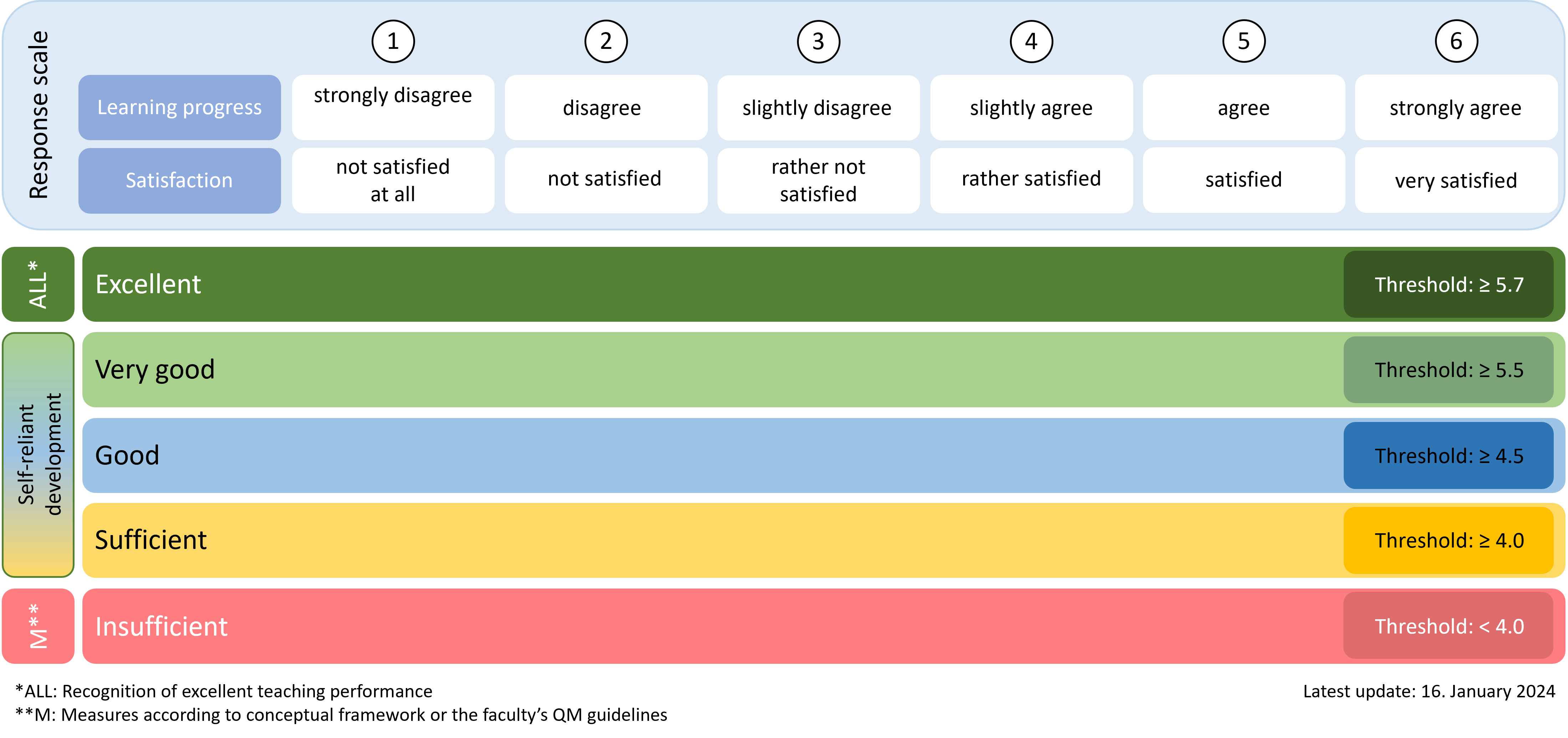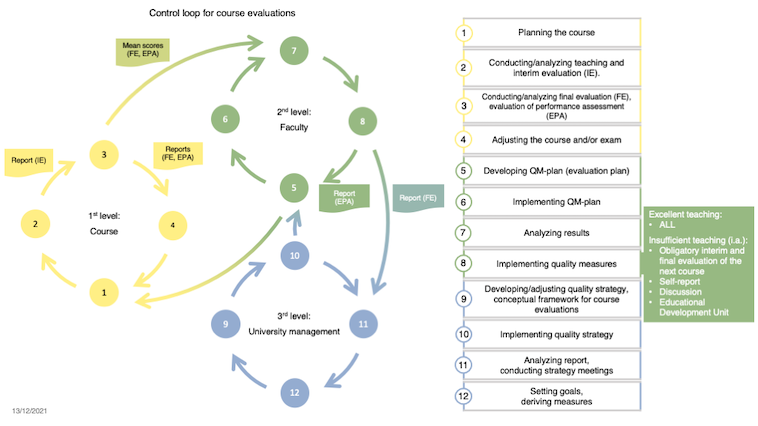Conceptual Framework for Course Evaluations
The framework concept for the implementation and use of course evaluations provides an overview of the measures for quality assurance and development (QSE) at course level. The most important points of the framework concept are described on this page.

Purpose of evaluations
Course evaluation at the University of Bern fulfils several purposes. It is carried out in the form of student surveys and thus involves students in the design of teaching (right to have a say). Based on the data obtained in this way, the evaluation provides concrete indications for improving teaching and learning situations (improvement orientation). Finally, it serves as proof of quality for legislators and the public (accountability).
1) Proof of quality (accountability)
As universities fulfil a publicly funded and legally regulated educational mandate, they are obliged to make the implementation and achievement of the objectives of the services they offer (in this case, courses) transparent to legislators and the public.
The evaluation of courses is an important component of a university's quality assurance and development system and therefore a prerequisite for successful institutional accreditation. Only accredited universities may continue to call themselves ‘universities’ and are eligible for federal funding.
A functioning system for the evaluation of courses and performance assessments is required in accordance with quality standards 3.2 and 3.4 of the Higher Education Funding and Coordination Act (HFKG).
In addition, the evaluation serves the purpose of internal monitoring and accountability to the university management.
Read more:
Swiss Accreditation Council SAR
Quality standards HFKG for institutional accreditation
2) Further development (improvement orientation)
The evaluation results are used to further develop teaching. The aim here is to identify the strengths and weaknesses of teaching in order to generate ideas for improvements.
The results of the evaluations (interim, final and performance assessment evaluations) are used to improve teaching on two levels:
- Lecturers use the results to further develop their own concept (learning outcomes, teaching/learning activities, examinations).
- The faculties and institutes use the results to optimise the conditions and framework for good teaching.
3) Right to have a say
By participating in the surveys, students have the opportunity to communicate their opinions on the courses and performance assessments and are thus involved in the design of teaching. The right to have a say is anchored in the quality standards for institutional accreditation.

Good Teaching Model
In order for the course evaluation to fulfil its purpose, it must answer the following question:
To what extent is good teaching being implemented in courses at the University of Bern?
But what does ‘good teaching’ mean?
Based on the findings of teaching-learning research, teaching is considered ‘good’ when three decisive factors are well aligned (‘didactic coherence’ or ‘constructive alignment’):
- the intended learning outcomes
- the teaching and learning activities
- the performance assessments
Following on from these findings and the multidimensional model of teaching quality by Rindermann (2009), a model of teaching quality was developed at the University of Bern. The model maps the quality-relevant dimensions of a course and a performance assessment, defines the target criteria and their interrelationships (see figure).
The model is the basis for our survey questionnaires.
The data obtained in the surveys show the areas in which there is potential for improvement for the respective course or performance assessment.

Method, example questionnaires, content & goals
Method
Course evaluation at the University of Bern is based on student feedback, a valid means of assessing course quality (e.g. Treischl & Wolbring, 2017; Fondel et al, 2015; Spooren et al, 2013; Marsh, 2007).
Example questionnaires
- Interim evaluation: online
- Final evaluation: online
- Supplementary modules to final evaluation: e-learning / Student contributions / Team teaching / Application orientation / Interdisciplinarity
- Evaluation of performance assessment (exam): online
Contents & goals
The survey questionnaires of the three types of evaluation are harmonised in terms of content::
Interim Evaluation
The questionnaire for the interim evaluation is designed to visualise important prerequisites for good teaching. In terms of content, it focuses on the following dimensions: the conveyance of the topic and the behaviour of lecturer(s), the structuring of the course, the level of demands and the contribution of students..
Final evaluation
The questionnaire for the final evaluation should measure the achievement of the objectives of good teaching as briefly as possible. In terms of content, the questionnaire for the final evaluation therefore focusses on two of the three defined target criteria of good teaching: learning progress and satisfaction.
In order to cover additional, course-specific topics in the surveys, it is possible to add one or more additional module(s) to the core questionnaire for the final evaluation. The ratings within the additional modules are only used as information for the lecturers and are not included in the overall result (grading in success level) of the final evaluation.
The following supplementary modules are available:
- eLearning (suitable for courses with the use of digital tools)
- Student contributions (suitable for seminars)
- Team teaching (suitable for courses with the participation of several lecturers)
- Application-orientation (suitable for exercises, practicals)
- Interdisciplinarity (suitable for courses with reference to several disciplines)
Evaluation of the performance assessment
Performance assessments play a central role in university teaching because they have an impact on the learning behaviour of students and often on the teaching design of lecturers.
The questionnaire for the evaluation of performance assessments is therefore designed to provide information on how to improve the design of teaching and examinations from a student perspective.
The questionnaire focuses on the quality dimensions of a successful examination: the didactic coherence and the framework conditions as well as the learning behaviour of students, the level of difficulty and the self-assessed learning progress (achievement of objectives).
As an alternative to centralised evaluation using a standard questionnaire, faculties can use their own methods for evaluating performance assessments (e.g. focus group discussions), particularly for examinations with a small number of students and for examination formats that are not written or oral examinations.

Frequency of evaluations
The evaluations follow a regular cycle that is defined in the framework concept:
Final evaluation
The conceptual framework requires that, at a minimum, each course and all instructors are evaluated at least once every three years. Within this framework, individual faculties plan final evaluations according to their own and monitor compliance with them. The final evaluation is mandatory for new types of courses and newly hired instructors, as well as for instructors in qualification positions (e.g. assistant professorships with tenure track).
The minimum requirement is to evaluate each course at least once every three years. Within this framework, the faculties plan their evaluations according to their own regulations and monitor compliance. The final evaluation is mandatory for new types of courses and newly appointed lecturers, as well as for lecturers in qualification positions (e.g. assistant professorships with tenure track). Courses that were rated as ‘’insufficient‘’ in the previous evaluation must be re-evaluated the next time they are held.
Evaluation of the performance assessment
The minimum requirement is that 50% of all performance assessments are evaluated at least once every 3 years. The faculties plan the evaluations according to this framework and select the performance assessments to be evaluated taking into account the regulations.
Interim evaluation
For courses that were graded as ‘’insufficient‘’ in the previous evaluation, the interim evaluation must also be carried out the next time the course is held.
Lecturers may also voluntarily register their course for interim, final or performance assessment evaluation.

Data collection times
The evaluations take place at three different time slots during the semester.
For the recommended registration deadlines and specific implementation periods for the current semester, see Deadlines.
Interim evaluation
- Recommended registration deadline: End of semester week 3
- Default evaluation date: 1st half of the course schedule, by the 9th week of the semester at the latest (depending on the course schedule)
Final evaluation
- Recommended registration deadline: End of semester week 8
- Default evaluation date: Towards the end of the course dates, starting from the 11th week of the semester
Evaluation of the performance assessment
- Recommended registration deadline: End of semester week 10
- Default evaluation date: starting from the 12th week of the semester, after the performance assessment (usually at 8pm on the day of the examination, before the grades are announced, unless otherwise agreed)

Rating criteria & consequences of rating
The results from the final evaluation are categorized into one of 5 performance levels. The categorization is based on the overall score of a final evaluation. Mean values from questions 1.1 - 1.3 (learning progress) and 2.1 - 2.5 (satisfaction) are taken into account.
From FS24 onwards, the following performance levels and threshold values apply, which were determined in collaboration with the faculties and an external expert:
- ≥5.7 = «excellent» (dark green level)
- ≥5.5 <5.7 = «very good» (light green level)
- ≥4.5 <5.5 = «good» (blue level)
- ≥4.0 <4.5 = «sufficient» (yellow level)
- <4.0 = «insufficient» (red level)
The highest rating, «excellent», is linked to the ALL project (Recognition of excellent teaching performance).
Measures defined in the framework concept and the faculty guidelines are applicable if if the results are ‘inadequate’.
The interim evaluation is not assessed a priori, as it is designed to provide formative and improvement-oriented feedback only. Lecturers are responsible for making use of the results.

Quality assurance and development of courses
The quality assurance and development of the courses is organised in the form of a control loop with three interrelated levels:
First level: Course
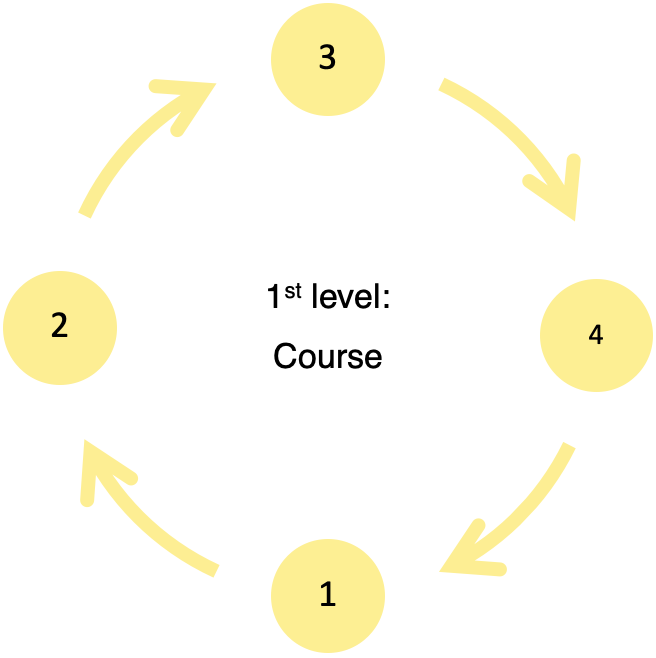 The lecturers are responsible for the QAD at the level of the individual course. They organise the course taking into account the previous evaluation results (1). They conduct the course and the evaluations and use the results of the evaluations to derive suggestions for improving the next course and, if necessary, performance assessment (2/3). The results and planned adjustments (4) are communicated to the students where possible.
The lecturers are responsible for the QAD at the level of the individual course. They organise the course taking into account the previous evaluation results (1). They conduct the course and the evaluations and use the results of the evaluations to derive suggestions for improving the next course and, if necessary, performance assessment (2/3). The results and planned adjustments (4) are communicated to the students where possible.
Second level: Faculty
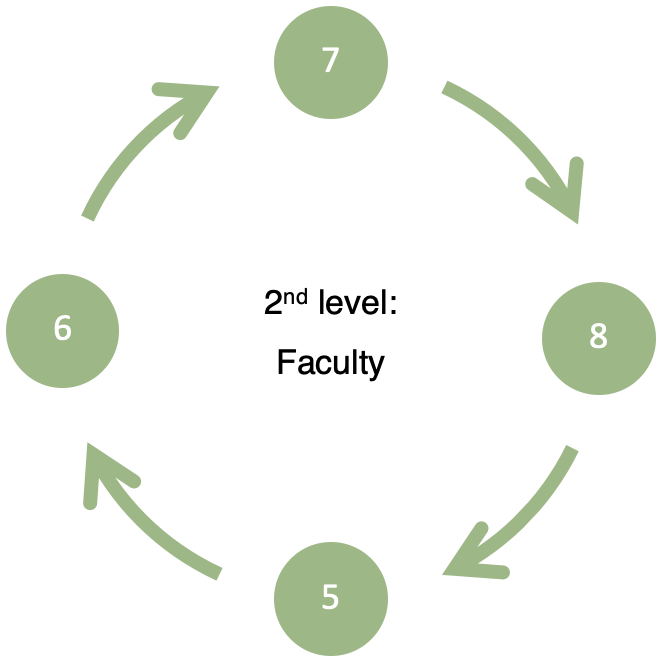 The faculties draw up an evaluation plan (5) and ensure its implementation (6). The quality representatives of the faculties receive aggregated results of the final evaluation and the evaluation of the performance assessments (7) from the Teaching Evaluation Office and take appropriate measures (8), which are defined in the framework concept and in the faculty regulations (8).
The faculties draw up an evaluation plan (5) and ensure its implementation (6). The quality representatives of the faculties receive aggregated results of the final evaluation and the evaluation of the performance assessments (7) from the Teaching Evaluation Office and take appropriate measures (8), which are defined in the framework concept and in the faculty regulations (8).
Third level: University management
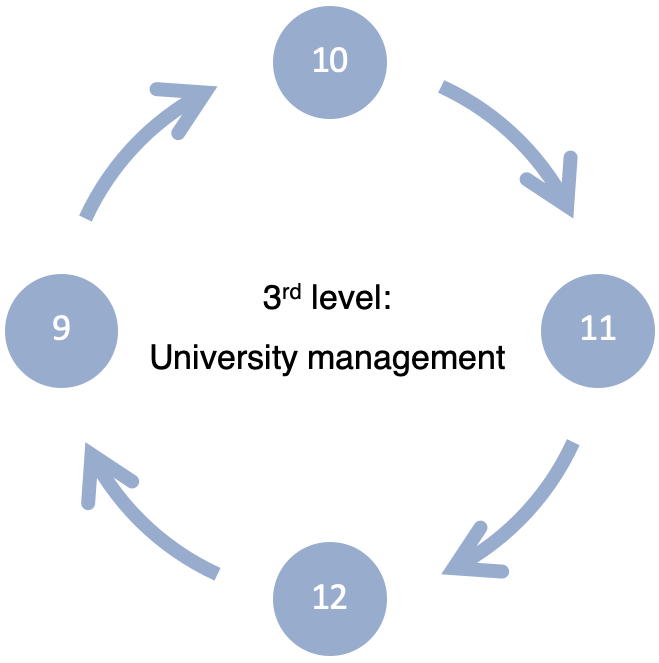 At the end of the academic year, the quality representatives of the faculties submit a report to the Teaching Evaluation Office. They reflect on the results of the evaluations, put them into context and report on the measures planned or already taken.
At the end of the academic year, the quality representatives of the faculties submit a report to the Teaching Evaluation Office. They reflect on the results of the evaluations, put them into context and report on the measures planned or already taken.
The Teaching Evaluation Office then draws up a summarised report including a brief statement on the faculty reports and communicates the results to the university management. The results are discussed at the operational meetings or the strategy meetings as required (11). If necessary, specific objectives are then formulated and measures derived (12), which in turn result in adjustments to the overall process and/or to the quality strategy (9) and its implementation (10).


